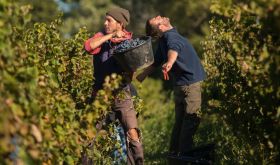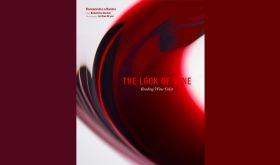20 January 2007 This is a longer version of an article also published in the Financial Times. See well over 1,300 tasting notes on this exceptional vintage and my overview of what made the wines taste the way they do.
'I’ve been 25 years in the wine trade and I’ve never known anything like it,' agent Graham Gardner surveyed Berry Bros & Rudd’s crowded annual burgundy tasting last week. He didn’t quite rub his hands together as he said it but he was virtually licking his lips when he added that as soon as he’d walked in, Berrys had given him an order for a further 50 cases. And when 2005 burgundy can cost a four-figure sum per case, this is clearly good news for a wine trade more used to dealing with over-supply and squeezed margins.
Family-owned Berry Bros and Diageo-owned Justerini & Brooks are the two big fine wine merchant rivals on St James’s Street in London. Each held tastings of scores of the much-heralded 2005 burgundies in the same imposingly Edwardian Great Hall in Westminster on successive days last week, and each has already sold well over £2 million worth of wine as a result. They could have sold considerably more of this much-hyped vintage if only they could have persuaded growers to increase their allocations. Indeed Berrys had mailed out their printed offer before the tasting. Such was demand – particularly for the grandest, most expensive wines – that their man in Burgundy, Master of Wine Jasper Morris (talking to wine consultant Susie De Paolis on the extreme left of the larger version of this picture of a Berry Bros tasting you can see above) told me,'it’s just a bonus to be able to taste them really. By last Friday, two days after the offer went out, we’d already sold as much wine as we did in the whole of the 2004 campaign.' Usually at these events, the wine merchant’s role is to encourage tasters to visit the order table. This year Morris was seen touring the tasting tables trying, generally in vain, to persuade the Burgundians present to sell him some more wine.
His counterpart at Justerini’s, Hew Blair, had been notable at last year’s tasting for taking calls on his mobile from customers telling him to spend five- and even six-figure sums on their behalf. This year such liberality would have been difficult to effect and the firm deliberately pruned their invitation list, limiting the number of customers allowed to taste the wines, knowing that allocating the most sought-after wines may please one customer but leave a dozen aggrieved, not least because poor weather during the June flowering and a particularly dry season yielded much less wine in 2005 than in 2004. As another Master of Wine, Nick Clarke who represents Joseph Drouhin in the UK, put it chez Berrys, 'we’re all trying to buy more wine. It’s great to have the demand for it, but it’s a nightmare trying to satisfy everyone.'
These were just two among a total of 20 tastings of 2005 burgundies held in London last week, more than ever before. Over the last five years the second week of January has established itself in the UK wine-trade calendar as burgundy week. The merchants dash off to Burgundy practically nursing their New Year hangovers to collect samples from the growers they represent, virtually all the reds and the more serious whites still maturing in cask deep under the backstreets of the Côte d’Or’s wine villages, so these samples of 16-month-old ferments are mere approximations to how the wines are likely to taste once they have been bottled later this year and allowed to gather depth and glory over the next five to 15 or more years.
Red and to a certain extent white burgundy, made respectively from Pinot Noir and Chardonnay grapes, is notoriously capricious and prone to shine one day and not the next, even to go into a prolonged sulk perhaps for years at a time. Burgundy is also the most complex wine region in the world, perhaps because it is one of the oldest, remarkable not for how much it has changed since the days the wines were made by medieval monks but for how little. Vineyards are classified as grands crus (the greatest and best-favoured but generally tiny sites), premiers crus one rank below, village wines which are sold merely by the name of the village in which they are made and which constitute the great volume of burgundy produced, and wines made on the fringes of the villages which may be sold merely as Bourgogne (Burgundy in French). Almost all vineyards have been so subdivided by inheritance over the years that they have many different owners, with different competences as vinegrowers and winemakers, so the name of the producer is at least as important as the name of the vineyard or appellation.
And then there are the wines that are sold not by the person who grew the grapes and made the wine but with the name of a négociant, or merchant, on the label. Some of these are highly skilled winemakers and blenders with access to some of Burgundy’s finest fruit. (Even a grower such as Jean-François Coche-Dury of Meursault, who could sell every bottle with his name on it many times over, sells a proportion of his crop to négociants because he says his cellars are not big enough to handle all of it; others may do it for tax reasons.)
Truly understanding burgundy is a great deal more demanding than navigating one’s way around the neatly classified châteaux of Bordeaux – which produce far more wine than most Burgundian vignerons. One more big difference between France’s two most famous wine regions, an advantage or disadvantage depending on your point of view, is that with the exception of a handful of Burgundian producers such as Domaine de la Romanée-Conti, there is very little secondary market for a wine as complicated as burgundy. Once you spend the money you have to be fairly certain of wanting to drink it too. Another big difference is that the burgundy market is more transparent than the bordeaux one with its many middlemen between producer and customer. Burgundy prices reflect much more closely what growers themselves think the wine is worth and what they will eventually receive.
All of this, together with the fact that there have been steep price rises for 2005 burgundies, up to 40 per cent on the much more coolly-received 2004 vintage for some of the most sought-after wines, partly in anticipation of the less glamorous 2006 vintage, makes the current frantic demand for the 2005s all the more remarkable – not least because the major commentators are yet to pronounce on which wines to buy.
Slowly but surely however, the British at least have been turning into self-confident burgundy enthusiasts. 'People in the UK have become much better educated in picking burgundy,' according to Graham Gardner. 'Even the supermarkets have decent selections now.' Fortunately for the UK merchants allocating their 2005 grands crus, their assiduously courted well-heeled Asian customers are yet to fall en masse for burgundy [that comment certainly dates this article – JR 2015].
The world’s greatest concentration of big spenders on wine is on the coasts of the US. Have Americans similarly become connoisseurs of France’s other great wine region, however complicated? There has certainly been no lack of enthusiasm in recent New York auctions for the most drool-worthy combinations of provenance and famous vintage in the Burgundy sections of the catalogues, but these are simply the jewels in the crown. Growers in Burgundy report that American buyers are much more vintage-conscious than their British counterparts. Certain vintages magically attain an aura of glamour and desirability while others languish. There has been a lull in American wine buying of burgundy, most obviously during the notorious anti-French ‘freedom fries’ era during the Iraq war of 2003 but also as a result of the punishing dollar-euro exchange rate. But there is no doubt that 2005 has been anointed in the US as a golden vintage to buy, however expensive. And this is only partly a reflection of the hype surrounding the 2005 bordeaux offered last spring. Already those few American merchants making 2005 burgundy offers tend to have sold out of the top wines and some American burgundy enthusiasts are so keen to get their hands on the best 2005s that they have been trying to buy direct from the London merchants.
All of this may suggest that it would be a waste of time and space to pass on my observations about this vintage, but many wines are still available, particularly those with more modest appellations and price tags. And the great thing about 2005 is how very good many of the humbler wines of all are, even those labelled simply Bourgogne which are better and more uniform than I can ever remember. Indeed there is something almost a little absurd in the current rush to acquire the grandest, most expensive wines of the vintage at any price in a year when the weather was so free of problems that the particular advantages of the most favoured sites, those designated grands crus, were needed much less than in most years.
Perhaps some of the buzz surrounding this vintage is due to how unusually easy the wines are to taste at this early stage. The 2004s offered 12 months ago were – and still are – naturally high in acidity, and the samples shown in January 2006 had been plucked from cellars that had already seen cold winter temperatures which had had the effect of closing the wines down and making them more difficult to taste. Not only were the 2005 grapes unusually ripe and unusually healthy, this current European winter has been unusually mild in Burgundy, so the 2005 cask samples have been particularly fruity and easy to taste.
Dominique Lafon of Domaine des Comtes Lafon in Meursault is convinced that once the 2005s, full of super-ripe, healthy fruit which has so far managed to disguise their high charge of acidity and tannin, are in bottle, they may well close up for quite a while and, despite some predictions, could go through a much less attractive stage.
Between us, Julia Harding MW and I attended 18 tastings in London, and I spent a week in Burgundy in December tasting wines too grand to be shown in the scrum of a London trade tasting (yes, that assignment was particularly tough). We must have tasted a total of 1,500 different samples of this vintage and have noted considerable variation in quality and, especially, style.
You can read all our tasting notes on Purple Pages, and my observations about the wines and who made the best of what Nature delivered in this near-perfect vintage next Saturday.
Recent Burgundy vintages
2004 – Big crop. Overlooked and keenly priced. Lovely whites.
2003 – Small crop. Controversial, highly variable heatwave vintage. Some great reds. Fat whites.
2002 – Shaping up very nicely for both reds and whites.
2001 – A lighter year than many, just coming round.
2000 – Overshadowed by 1999 but has consistently provided charming drinking of whites as well as reds.
1999 – The last vintage of the century, and one might even call it the last ‘vintage of the century’, 2005 being the current one.
Recent Burgundy prices
Berry Bros’ opening price for 12 bottles of Domaine Jean Grivot’s Grand Cru, Clos de Vougeot in bond
2005 – £600
2004 - £480
2003 – £594
2002 - £498
2001 – £408
2000 – £402
1999 – £402














